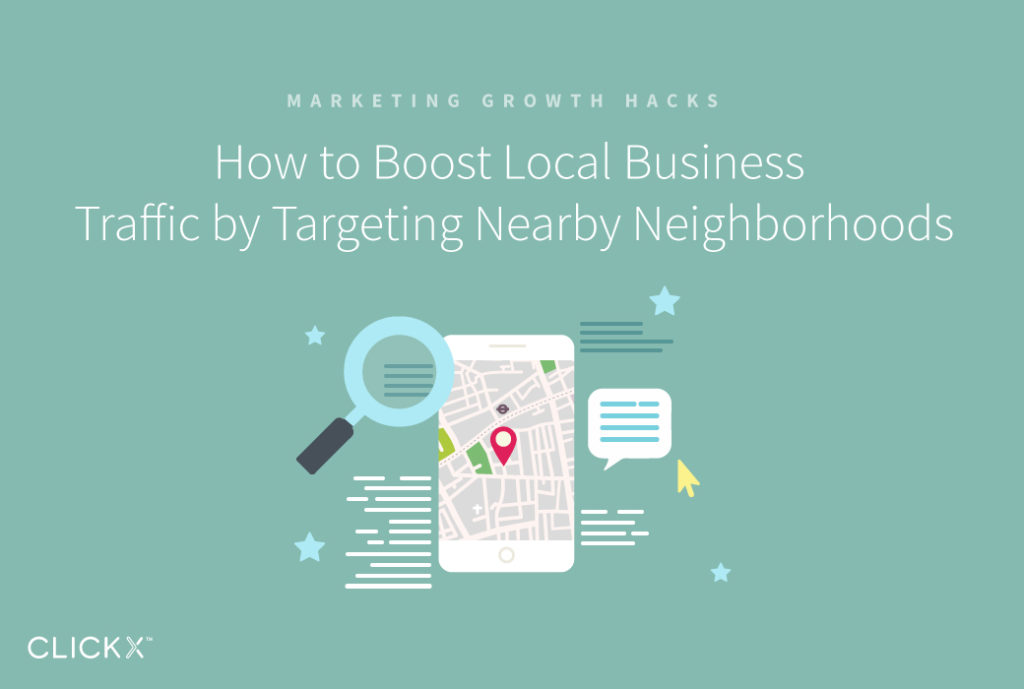How to Boost Local Business Traffic by Targeting Nearby Neighborhoods
Mobile search activity is now higher than desktop usage. Not only that, but mobile searches are more likely to be local, often driving purchasing decisions in the future. With the above in mind, as a business it makes a lot of sense to focus on mobile search—so how can you expand your long-tail keyword strategy to reflect this?
Our approach is beautifully simple: Put yourself in the mind of your customers. By doing so, you’ll be able to target neighborhood-specific keywords and boost local search traffic—and ideally, you’ll see an increase in foot traffic to match.
In this post, we’ll offer you two steps for targeting customers in the neighborhoods near your business, and show you how to implement them. Let’s get started!

Step 1: Analyze Customer Behavior
Start by mentally strapping on your customers’ shoes. What are they most likely to be doing in the area that could lead them to your business?
Consider this example: You run Acme Home Repairs in San Diego, California. A customer is out for lunch, and his spouse calls to remind him to schedule an appointment to get the garage door fixed. He quickly searches to see what businesses are near the deli that can solve the problem. This is the kind of eventuality we’re looking to cater to.
To do so, start by brainstorming the neighborhoods of San Diego. Pop open Google Maps to make sure you don’t forget any (and to double check any questionable spellings):

There are quite a few, but the closest ones to our example business are:
- Rancho Peñasquitos
- Black Mountain Ranch
- Carmel Mountain Ranch
- Mira Mesa
- Miramar
- Scripps Ranch
- Del Mar
- La Jolla
- Torrey Pines
As for what people will be doing in the area, there could be a multitude of activities depending on your business and location—from random or day-to-day tasks (such as popping out to lunch) to errands closely related to your business. Here are a few ideas to get you started, but you should come up with a list of your own:
- Grocery shopping
- Visiting a friend
- Picking up related supplies
- Researching a related project
You could implement a customer survey in-store to discover more. Slip in a question asking what events brought them into the store that day, and if you’re able to talk one-on-one to customers about it, even better!
[Tweet “Ask your customers what events brought them into the store that day.”]
Start cross referencing the replies you get with your list of local neighborhoods. What stores and nearby locations correlate with their behaviors, and which locations were they likely to be at before walking into your business? It’s easiest to start with chain stores, but what will really drive home the local content are stores unique to each area.
By now, you should have two or three specific places in mind for each nearby neighborhood to complement your list of activities. You’ll have three lists consisting of nearby neighborhoods, customer activities, and local businesses—and they can be combined to generate relevant keywords. For example: “grocery shopping at Albertsons in Scripps Ranch”.
By the end, you should have a fairly sizable list. Obviously these tasks need to be something people are likely to search for, so use your judgement to sort out keywords that don’t make sense.
Step 2: Address Immediate Customer Concerns
Now think about how the activities and locations can tie back into your customer’s needs. For each keyword, you can write a post your potential clients would find useful for that task, which will feature a to-do list to help them accomplish their errands in the area.
In our Acme Home Repairs example, look to focus on the elements that will matter most to your customers. For example, which specific stores are they most likely to be at? It may make sense to start with the related supply stores in the area.
While a lot of your research can be done using Google Maps Street View or relying on your own knowledge of the area, there’s no better way to research than by getting out into the neighborhood itself.
Here’s what your post needs to include to be successful:
- Choose a customer narrative based on the research and surveys you’ve completed. Stand at that location and try to imagine what comes next. Take pictures and notes, because you’ll want the nitty-gritty details.
- Adding images not only helps your reader, but can actually contribute to your optimization efforts.
- Each post should be personal to the specific neighborhood and location.
- Reference nearby landmarks such as parks, post offices, and statues. These local reference points all give your content that extra edge—for example, “Looking across the street from the central Mira Mesa Post Office, you’ll see…”
- Include addresses, preferably with a link to make it easy to grab directions.
- Make it meaningful by talking about the business values and deals they can find at the location you’re specifically targeting.
The trick to working this in your interest is to create a narrative that leads back to you. In other words, paint a descriptive story: “It’s a hot summer day so you decide to stop in for ice cream at the Mira Mesa Cold Stone…”
[Tweet “Provide an easy, local reference point for likely tasks on their to-do list.”]
Next, work your way through a short action list—“What else can you get done quickly while you’re in Mira Mesa?” For each item on your list, include the distance and times to each location. The goal here is to make it actionable and easy to follow.
For best results, cross reference other related customer behavior that often leads to your business. This all depends on the results from step one, and could range from grabbing a bite to eat to what type of convenience stores are nearby.
Most importantly, you need to creatively add your name to the list—“Been thinking about a home repair? Get a quote at Acme Home Repairs. It takes five minutes to get here and ten to get a quote.”
In the end, you’ll have a lot of posts with useful local information related to the activities that tend to draw your customers in. When people search to get these errands done, they’ll find your local tips. This content will help to boost local web traffic, increase brand awareness, and get more customers through the door!
Conclusion
Attracting local traffic can be as simple as targeting the usual behaviors of your customers in their daily routines, making it easier for them to find your business’ website when researching the neighborhood.
This is accomplished by finding out what your customers typically do before contacting your company, and offering useful local information related to those tasks. To review, here are the steps to follow:
- Brainstorm related local activities.
- Conduct an in-store survey to learn exactly what leads a customer to walk through your door.
- Create a list of keywords based on these activities and your nearby neighborhoods.
- Creqte an informative post around each keyword.
- Write about local tips and information to accomplish the local activities you gathered earlier.
- Tie everything back to your store by including your business within your content.
Have you built a local traffic content campaign before? Tell us your experiences in the comments section below!



